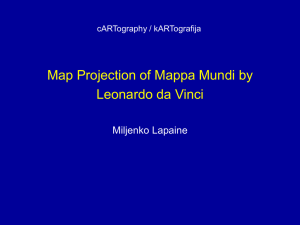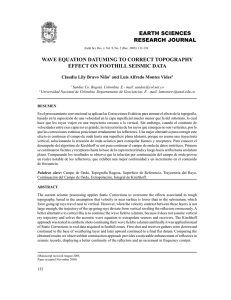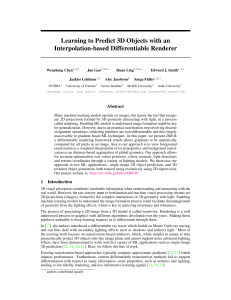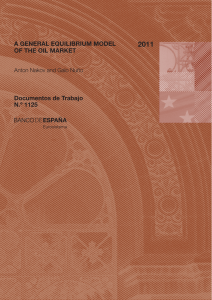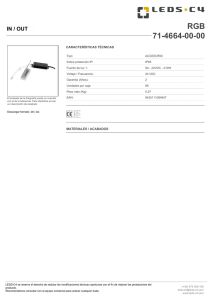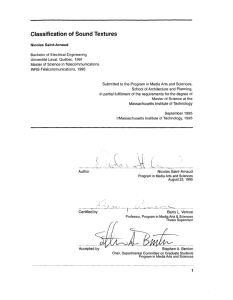Topometry and color association by RGB Fringe Projection Technique
Anuncio
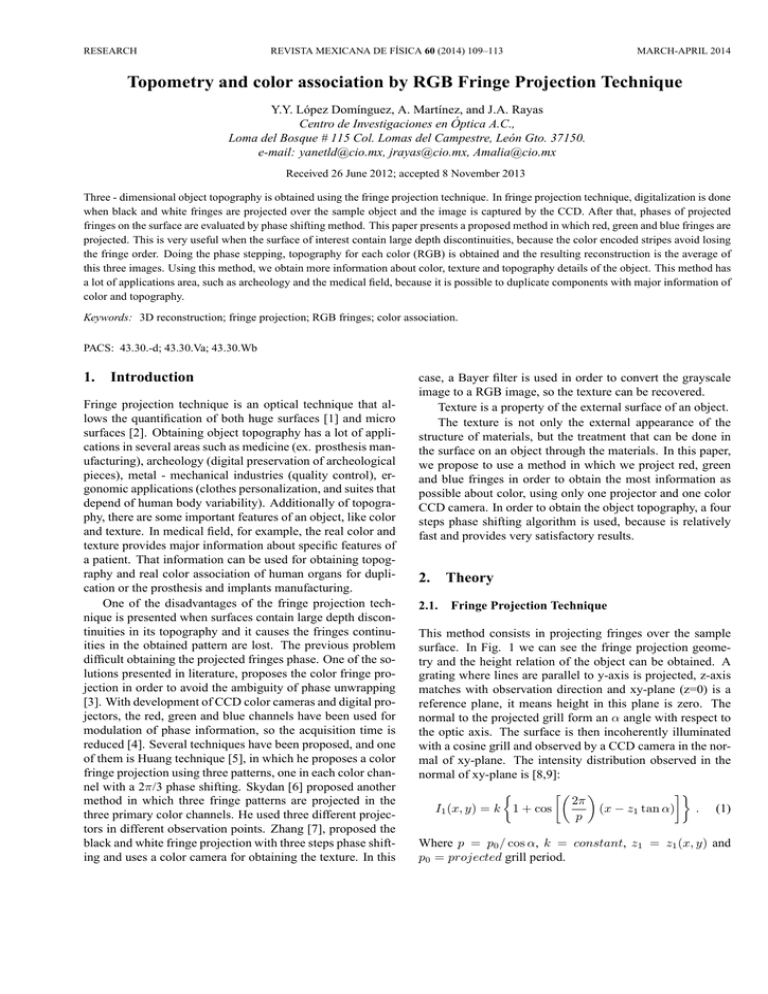
RESEARCH REVISTA MEXICANA DE FÍSICA 60 (2014) 109–113 MARCH-APRIL 2014 Topometry and color association by RGB Fringe Projection Technique Y.Y. López Domı́nguez, A. Martı́nez, and J.A. Rayas Centro de Investigaciones en Óptica A.C., Loma del Bosque # 115 Col. Lomas del Campestre, León Gto. 37150. e-mail: [email protected], [email protected], [email protected] Received 26 June 2012; accepted 8 November 2013 Three - dimensional object topography is obtained using the fringe projection technique. In fringe projection technique, digitalization is done when black and white fringes are projected over the sample object and the image is captured by the CCD. After that, phases of projected fringes on the surface are evaluated by phase shifting method. This paper presents a proposed method in which red, green and blue fringes are projected. This is very useful when the surface of interest contain large depth discontinuities, because the color encoded stripes avoid losing the fringe order. Doing the phase stepping, topography for each color (RGB) is obtained and the resulting reconstruction is the average of this three images. Using this method, we obtain more information about color, texture and topography details of the object. This method has a lot of applications area, such as archeology and the medical field, because it is possible to duplicate components with major information of color and topography. Keywords: 3D reconstruction; fringe projection; RGB fringes; color association. PACS: 43.30.-d; 43.30.Va; 43.30.Wb 1. Introduction Fringe projection technique is an optical technique that allows the quantification of both huge surfaces [1] and micro surfaces [2]. Obtaining object topography has a lot of applications in several areas such as medicine (ex. prosthesis manufacturing), archeology (digital preservation of archeological pieces), metal - mechanical industries (quality control), ergonomic applications (clothes personalization, and suites that depend of human body variability). Additionally of topography, there are some important features of an object, like color and texture. In medical field, for example, the real color and texture provides major information about specific features of a patient. That information can be used for obtaining topography and real color association of human organs for duplication or the prosthesis and implants manufacturing. One of the disadvantages of the fringe projection technique is presented when surfaces contain large depth discontinuities in its topography and it causes the fringes continuities in the obtained pattern are lost. The previous problem difficult obtaining the projected fringes phase. One of the solutions presented in literature, proposes the color fringe projection in order to avoid the ambiguity of phase unwrapping [3]. With development of CCD color cameras and digital projectors, the red, green and blue channels have been used for modulation of phase information, so the acquisition time is reduced [4]. Several techniques have been proposed, and one of them is Huang technique [5], in which he proposes a color fringe projection using three patterns, one in each color channel with a 2π/3 phase shifting. Skydan [6] proposed another method in which three fringe patterns are projected in the three primary color channels. He used three different projectors in different observation points. Zhang [7], proposed the black and white fringe projection with three steps phase shifting and uses a color camera for obtaining the texture. In this case, a Bayer filter is used in order to convert the grayscale image to a RGB image, so the texture can be recovered. Texture is a property of the external surface of an object. The texture is not only the external appearance of the structure of materials, but the treatment that can be done in the surface on an object through the materials. In this paper, we propose to use a method in which we project red, green and blue fringes in order to obtain the most information as possible about color, using only one projector and one color CCD camera. In order to obtain the object topography, a four steps phase shifting algorithm is used, because is relatively fast and provides very satisfactory results. 2. 2.1. Theory Fringe Projection Technique This method consists in projecting fringes over the sample surface. In Fig. 1 we can see the fringe projection geometry and the height relation of the object can be obtained. A grating where lines are parallel to y-axis is projected, z-axis matches with observation direction and xy-plane (z=0) is a reference plane, it means height in this plane is zero. The normal to the projected grill form an α angle with respect to the optic axis. The surface is then incoherently illuminated with a cosine grill and observed by a CCD camera in the normal of xy-plane. The intensity distribution observed in the normal of xy-plane is [8,9]: ¸¾ ½ ·µ ¶ 2π (x − z1 tan α) . (1) I1 (x, y) = k 1 + cos p Where p = p0 / cos α, k = constant, z1 = z1 (x, y) and p0 = projected grill period. 110 Y.Y. LÓPEZ DOMÍNGUEZ, A. MARTÍNEZ, AND J.A. RAYAS I1 = a + b cos(φ) I2 = a + b cos(φ + 90◦ ) I3 = a + b cos(φ + 180◦ ) I4 = a + bcos(φ + 270◦ ) (5) From these expressions, a possible solution for the phase is obtained: I2 − I4 tan φ = − (6) I1 − I3 2.3. F IGURE 1. Fringe projection technique geometry. A second surface z2 = z2 (x, y) can represent a deviation respect a z1 surface, which is plane, then the intensity of this second surface is represented by: ¸¾ ½ ·µ ¶ 2π (x − z2 tan α) . (2) I2 (x, y) = k 1 + cos p From the previous equations, the height relation of the object can be obtained: z(x, y) = φ p . 2π tan α (3) Where z(x, y) is the depth measured from grill, φ is the phase difference between the grill in the plane reference (z = 0) and the deformed grill, p is the period of the grill in the plane reference, α is the formed angle between the projected grill normal and the reference plane normal. 2.2. Phase measurement The intensity of a fringe pattern is given by: I(x, y) = a(x, y) + b(x, y) cos[φ(x, y) + ∆φ] (4) Where a(x, y) describes variations of the background intensity in the fringe pattern, b(x, y) describes the fringes amplitude, φ(x, y) is the information about the phase we are looking for and ∆φ is a introduced phase shifting. Equation (4) contains 3 unknown factors, a, b y φ, so, three intensity measurements are required in order to determine the phase. A phase detection sampling algorithm is defined by the number of sampling points, its phase position and its associated weight sampling. Although three steps are sufficient to determine the three unknown constants, small measurement mistakes can have a big effect in the results. In this case, the four steps method is better [10]. The intensity values are measured using four different phase values: ∆φ1 = 0◦ , ∆φ2 = 90◦ , ∆φ3 = 180◦ y ∆φ4 = 270◦ . Texture and Color The texture is the property of the external surface of an object. It can be perceived through the view or touch. The texture of an element is the first thing we perceive throug the view and it is related with the physical and chemical characteristics of the object we are observing. The texture of an element not only transmits the physical - chemical characteristics, but in our perceptive memory we have sensations related with the objects too (sand is rough, metal is cold, silk is soft, etc). The texture is formed basically by two elements: the physical properties (external appareance) and color. The sensations that they both transmit is subjective, because they depend on the spectator experience. Color is a subjective sensation that spectator experiments under very specifics conditions of light. Every object absorbs a part of the electromagnetic wave and reflects the remaining. The reflected waves are captured by the photoreceptors in the retina and sent to the brain. These signals are interpreted in the brain as different colors according to the corresponding wavelengths. In order to specify a color, we need three attributes: Hue: The dominant wavelength that allows us to distinguish the yellow from red, green from blue, and so. Saturation (Purity): Is the proportion of pure light from the dominant wavelength and allows us to distinguish if a color is strong, weak or pale. Intensity (Luminance): Is the intensity of the light and allows us to distinguish the dark colors from light colors [11]. 3. Experimental Method In order to obtain the object topography, a fringe pattern is projected on the object surface and using the phase shifting algorithm (Eq. 6), the phase information is obtained. Topography finally is obtained using Eq. (3). As we know, all information about color of an image is found in its three channels, which are red, green and blue. Therefore, in order to recover the real color of an object, a color fringe projection is proposed. It means that a red fringe pattern is projected on the surface object, then a green fringe pattern and finally a blue fringe pattern. The experimental system is shown in Fig. 2. The distance between CCD camera and the center of coordinates system is 54.02 cm and the Rev. Mex. Fis. 60 (2014) 109–113 TOPOMETRY AND COLOR ASSOCIATION BY RGB FRINGE PROJECTION TECHNIQUE 111 F IGURE 2. Fringe projection experimental system. distance from projector to the origin is 51.6 cm. In this case, the obtained projection angle is α = 17.21◦ . As we use four steps - phase shifting technique, the fringes patterns are out of phase 90◦ between each other. The images are obtained using a color camera, in this case, a PL-B776 with 2048×1536 pixels resolution. The used digital projector has 800 × 600 pixels resolution. So, twelve images are obtained, four with red fringes, four with green fringes and 4 with blue fringes, each one with its corresponding reference image. After that, using a program developed in C and based in Eq. (6), the images were processed using the phase shifting technique in order to recover the wrapped phase of the object. Before we obtain the phase, the images were filtered in order to avoid that information of another color interferes with the information of the current image. A color image is compound of three channels (RGB), so when the group of red images is being processed, the green and blue channels are set in zero and the same process with the green and blue images. In order to unwrap the phase, we use the following method: • The difference between the neighbor points and the current point is calculated. F IGURE 3. Object with projected fringes b) Object topography obtained. • If the difference is greater than K*2π (threshold), it means that there is abrupt change of phase. Then ◦ If the difference is greater than zero, we add 2π to the current unwrapped phase. ◦ If the difference is less than zero, we subtract 2π to the current unwrapped phase. • If the difference is less than K*2π, the current point of the wrapped phase is added to the previous point of the unwrapped phase [10]. By this process along the entire wrapped phase matrix, the unwrapped phase is obtained. In order to obtain the topography, it is necessary to do the same process with the reference images, it means, calculate the wrapped phase of the reference (carrier) and then unwrap the phase. The topography is obtained subtracting the unwrapped phase of the carrier to the unwrapped phase of the object. F IGURE 4. a) Images captured with RGB fringes, b) Resulting image obtained by superimposing texture to the object topography. Rev. Mex. Fis. 60 (2014) 109–113 112 Y.Y. LÓPEZ DOMÍNGUEZ, A. MARTÍNEZ, AND J.A. RAYAS All images have to be taken under same conditions of light. Then, when we average the three groups (RGB) of color images, we obtain three images without fringes. Doing the average of these three images, the resulting image contains information about the color and texture of the object and its variations under the three kinds of illumination. With an algorithm developed in C the resulting color image is superimposed pixel by pixel to the topography obtained previously. As we can see in Fig. 4b, we can perceive that the texture of the skin is smooth because there are no discontinuities but a little dark. The resulting image with color associated is a little dark or opaque. This is because we are averaging the images, so some of them (specially the images with blue fringes) have less brightness than the others. To correct this problem, we used another option that consists in illuminate the object with a white light source and removing another kind of exterior illumination sources. We get only one shot of a color image, so it can be used to associate the color thus avoiding the average of all the color images used in the previous method. Following the same RGB fringe projection procedure described previously, the topography is obtained. We can see in Fig. 5 that the resulting image appears a little more clear or brighter than the imaged obtained with the previous method. Another detail we can perceive is that texture appears to be rough mainly in the top and center of the object. 4. F IGURE 5. a) Sampling object, b) Unwrapped phase, c) topography with color associated. This process is done with every group of images, so we recover three topographies, each one for every color fringes pattern. For the texture and color association, the four images corresponding to the phase shifting in each color were averaged in order to eliminate the fringes and the resulting image contains information about texture and color. Results and discussions The methodology of the work consists in projecting RGB fringes and obtains the corresponding topography of the every color fringes group projected. To obtain the object texture, we probed dos different methods. First method consists in average the four images corresponding to the phase shifting in each color and concatenating them in a new color image. Second method consists in illuminating the sample object with a white light source and eliminating the background illumination. In this case, we captured only one image for the texture. The results with the first method show el associated color a little dark, but the result with second method is brighter. The computational time with second method has been reduced and the topography evaluation and color association were satisfactory. The measures obtained with Eq. (3) about the depth were compared with the measures of the object using a calibrated vernier (certified) and the maximum error was 0.03 mm. So, we can see that fringe projection method is very reliable and accurate. 5. Conclusions Experimental results for the topography measurement have been presented with color and texture association. The con- Rev. Mex. Fis. 60 (2014) 109–113 TOPOMETRY AND COLOR ASSOCIATION BY RGB FRINGE PROJECTION TECHNIQUE 113 tribution of this work is the use of RGB fringes instead of grayscale fringes used in conventional methods. With this method we realized that it has a lot of advantages such as the use of color fringes allows obtaining to obtain better details of the object topography, its color and texture. Although at the same time, it introduces more noise in the captured images. There is a lots of parameters for improving, such as a better illumination system to avoid generating unwanted shadows, which make the three-dimensional reconstruction of the object show peaks that don’t exist. Once we improve the to- pography algorithm, we will proceed to the next stage that consists in pieces duplication, obtaining a preliminary model using the fast-prototyping method. 1. A. Martı́nez, J. A. Rayas, H. J. Puga, Katia Genovese, “Iterative estimation of the topography measurement by fringe projection method with divergent illumination by considering the pitch variation along the x and z directions”, Vol. 48 N◦ 9, (Optics and Lasers in Engineering, a publicarse en September 2010). pp. 877-881. 5. P.S. Huang, Q.Y. Hu, F. Jin, F.P. Chiang, Optical Engineering 38 (1999) 1065-71. 2. J. A. Rayas, R. Rodrı́guez Vera, A. Martı́nez, “Threedimensional micro-topography by Talbot-projected fringes”, fifth symposium Optics in Industry, edited by Eric Rosas, Rocı́o Cardoso, Juan C. Bermudez, Oracio Barbosa Garcı́a, Proc. Of SPIE, Vol. 6046 (SPIE, Bellingham, WA January 2006), pp. 60461 y-1 to 60461 y-6. 3. Wei Hung Su, Optics Express 15 (2007) 13167. 4. Z. H. Zhang, C. E. Towers, D P Towers, Journal of Optics A: Pure and Applied Optics 9 (2007) S81 - S86. Online at www.stacks.iop.org/JOptA/9/S81 Acknowledgements This research is part of the project supported by Conacyt through grant 180449 and the PhD program scholarship granted by Conacyt. 6. O.A. Skydan, M.J. Lalor, D.R. Burton, Optics and Lasers in Engineering 43 (2005) 801 - 14. 7. Song Zhang, Shing-Tung Yau, Optical Engineering 47 (2008) 123604. 8. A. Martı́nez, J.A Rayas, J. M. Flores M, R. Rodrı́guez Vera, D. Donato Aguayo, Rev. Mex. Fis. 51 (2005) 431 - 436. 9. Kjell J. Gasvik, “Moiré Methods. Triangulation” en “Optical Metrology”, (Wiley 2002, Third Edition). pp 173 - 190. 10. D. Malacara, M. Servin, Z. Malacara, “Phase shifting interferometry” en “Interferogram analysis for optical testing”, Marcel Dekker, Inc 1998, pp 247 - 278. 11. D. Malacara, “Color vision and colorimetry: Theory and applications”, (SPIE Press, USA, 2◦ Edition 2011) Rev. Mex. Fis. 60 (2014) 109–113
